|
ABSTRACT
Before the start of Green Revolution there were over 100,000 native varieties of rice in India. These
were the results of selection and propagation by the indigenous farmers through 5000 years of efforts.
It is feared that over the last few years, due to the introduction of high yielding new varieties from
elsewhere and hybrids bulk of Indian varieties have gone extinct. This is unbelievable loss for the
gene pool of rice, prime staple food-grain of the world. There is still hope that through field surveys,
especially in places of high landscape heterogeneity, the remaining native rice varieties can be located
in farmers’ fields and saved from extinction through promotion of in situ conservation. As a
preliminary exercise we carried out a field survey in about 300 villages of Uttara Kannada to prepare
an inventory of rice varieties grown, through interviews with the farmers. Data was gathered also
about the notable characteristics and desirable features of these varieties. Out of about 178 rice
varieties inventorised about 95 were native varieties. Most of these are taller to hybrids and other new
varieties, over 5-6 in height and yield more fodder for cattle. Though their yields are relatively lower
they have more resistance to pests and diseases. Their grains are bolder and longer and the rice comes
in white, red and brownish colors. Some like Sannakki and Jeerigesali are fragrant. Doddabatha and
Kagga are good for making rice flakes. Chitagya, Doddagya, Halaga, Hasadi etc. are attributed with
medicinal properties. Salinity tolerance is found in Bilikagga and Karikagga grown in estuarine fields.
Lot of choice exists for selection of rice of different durations, such as Jaddubatha and Kannuru of 90-
100 days, Bantwala, Mullarya and Mysore Sanna of 100-120 days, Dibanasale of 120-140 days and
Aloorsanna, Honnekattu etc. needing over 140 days. Long duration varieties are good for places with
prolonged rainy periods and short duration for lower rainfall areas and irrigated fields. As most of
native varieties are grown with organic manure and least or no use of pesticides they are good for
human health and their fields ideal for fishes and frogs and other aquatic fauna as well as for birds
which feed on them. In this poster GIS maps on the distribution of the native varieties are given along
with pictures of many of them. The poster highlights the need for encouraging the growers of native
varieties through honouring them and providing subsidies for conservation of rare ones.
INTRODUCTION
-
Rice is an economically important food crop. It feeds nearly half the world’s population and accounts for more than 50% of their daily calorie intake (Maclean et al. 2002).
-
The world is losing genetic diversity of rice
-
Major reason for this loss is the steady replacement of native varieties with high-yielding new varieties in large scale.
-
India: Land of genetic diversity of rice (100,000 local varieties) and about 90% are feared to be lost
IMPORTANCE OF TRADITIONAL VARIETIES
-
Diverse qualities for rice- height of plant, colour, size, aroma, maturity and habitat.
OBJECTIVES
-
To trace out traditional varieties remaining in Uttara Kannada
-
To find out their special characters
-
To estimate number of traditional varieties in the district using field survey and regression analysis for prediction of expected number in the district
RESULTS AND DISCUSSION
Altogether, a total of 181 rice varieties were inventoried from 232 villages, during this survey. Of these, 101 varieties were traditional ones; 80 were new varieties, considered high yielding.
Taluk-wise numbers found and numbers expected are presented in the table:1
HABITAT SPECIALIZATIONS
-
For flood tolerance
Eg: Neermulka; Mysore mallige;
-
Salinity tolerance
Eg: Bili-kagga; Kari-kagga.
-
Drought tolerance
Eg:Jeddkempi; One-kaddi.
-
Variable maturity periods: Halga, Jeddubatha (90 -100 days); Dibnasaala, Bantwala (100 -120 days); Hegge, Aloorusanna ( 120 -140 days)
Table 1: Traditional rice varieties with expected varieties in 11 taluks of Uttara Kannada
| Taluks |
Village covered |
|
Total varieties
encountered |
Expected traditional varieties |
| Traditional |
New varieties |
| Total |
232 |
101 |
80 |
181 |
492 |
| Ankola |
17 |
18 |
14 |
32 |
81 |
| Bhatkal |
16 |
14 |
15 |
29 |
45 |
| Haliyal |
20 |
15 |
12 |
27 |
92 |
| Honnavar |
21 |
25 |
15 |
40 |
93 |
| Joida |
2 |
1 |
10 |
11 |
- |
| Karwar |
11 |
9 |
10 |
19 |
45 |
| Kumta |
42 |
39 |
17 |
56 |
112 |
| Mundgod |
10 |
8 |
10 |
18 |
68 |
| Sirsi |
45 |
35 |
28 |
63 |
155 |
| Yellapur |
11 |
20 |
13 |
34 |
218 |
| Siddapura |
36 |
33 |
34 |
67 |
165 |
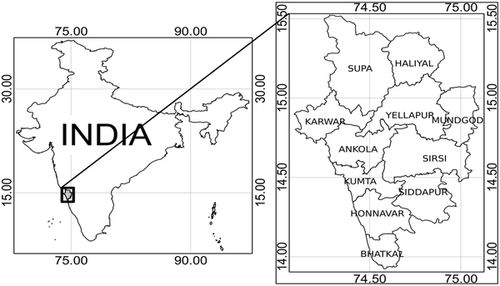
Figure 1: Map of Uttara Kannada district with 11 taluks
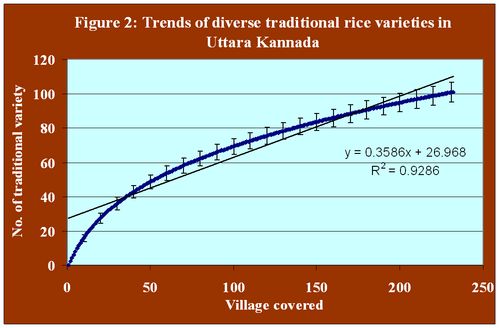
Figure 3: Village-wise diversity sampling trends regarding traditional rice varieties in 10 taluks of Uttara Kannada (after rarefaction)
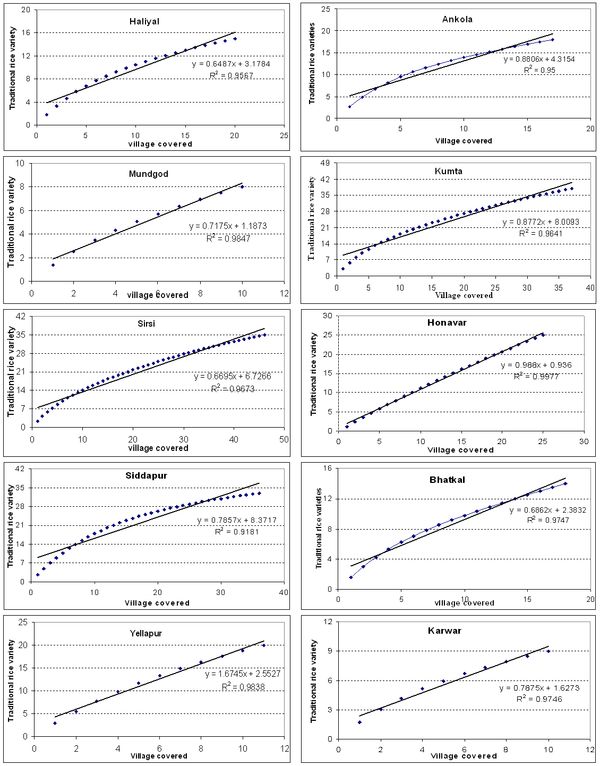
Some traditional rice varieties in Uttara Kannada
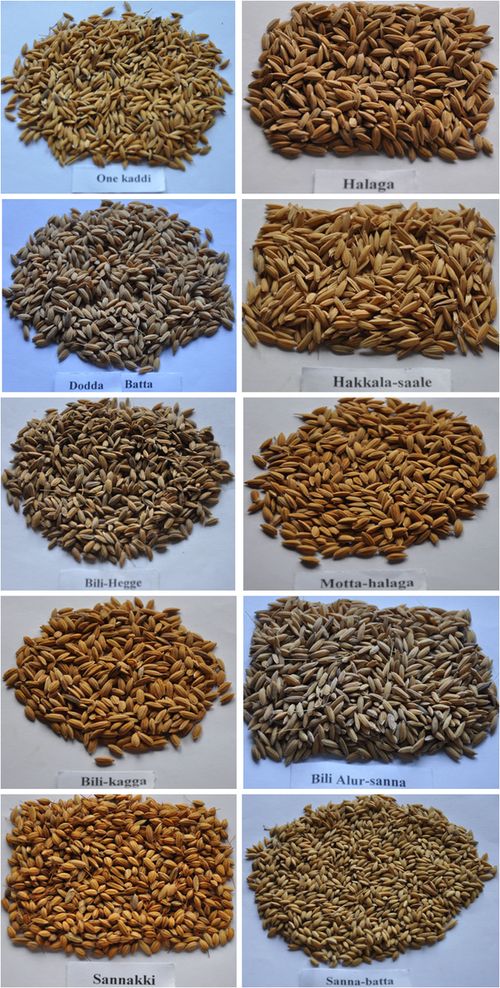
A widely adapted and high yielding local variety
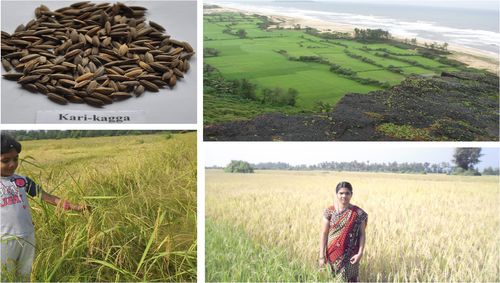
CONCLUSIONS
- Introduction of new varieties has caused fodder crisis in the district which is adversely affecting milk production and availability of cattle dung for manure
- We have predicted using the sample survey method and regression analysis the talukwise numbers of local varieties available in Uttara Kannada; with nearly 500 expected varieties
|






